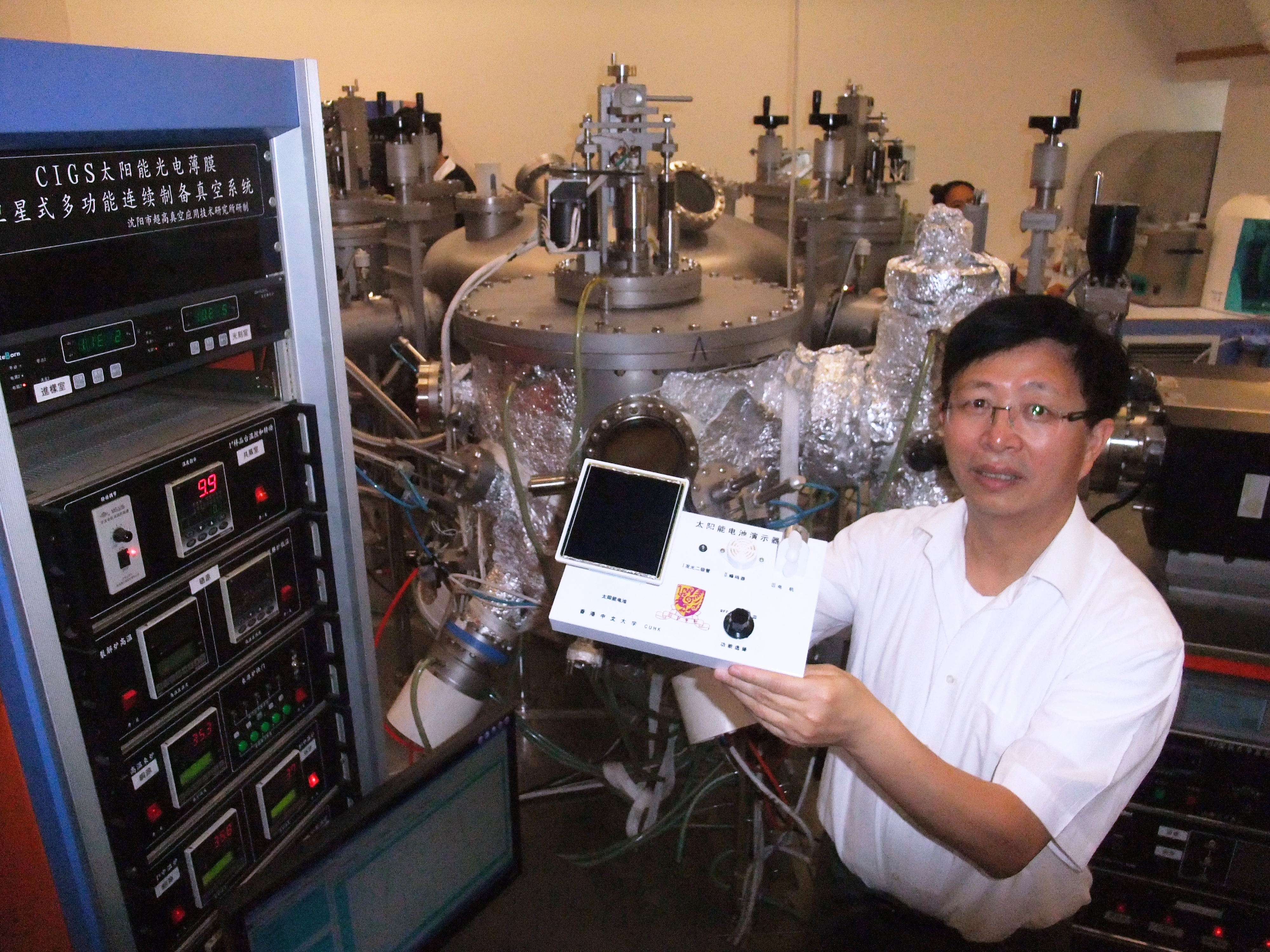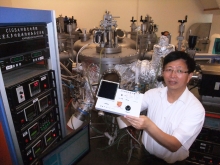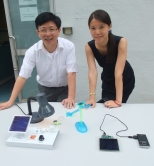CUHK
News Centre
CUHK Green Pioneer SeriesCUHK Makes Strides in Renewable Energy Developmentwith High-Efficiency Thin Film Solar Cell
A research team led by Prof. Xudong Xiao and Prof. Quan Li of the Department of Physics at The Chinese University of Hong Kong (CUHK) successfully developed Cu(InGa)Se2 (CIGS) thin film solar cells that feature low production cost, high efficiency and extensive application prospects. Its conversion efficiency of 17% is the highest among the same kind of solar cells in the greater China region and reaches world-class level, representing a great breakthrough in the development of renewable energy. The CIGS solar cell features thin and portable character, stable performance, low fabrication cost and wide applications. It can be installed on roofs and outer walls of buildings in Hong Kong; it can also be integrated into consumer products such as handbags and backpacks for charging electronic products instantly, and be used to power electronic devices for the space industry.
The demand for energy is ever increasing with economic development and population growth. The over-consumption of traditional fossil fuels (e.g. coal and natural gas) causes energy crisis and environmental pollution. Currently about 75% of electricity in Hong Kong is generated by burning coal and natural gas, while the remaining 25% mainly comes from nuclear energy. The burning of fuels generates air pollutants and carbon emission that cause greenhouse effect; while the recent nuclear leakage accident caused by the earthquake in northeastern Japan has raised worldwide concerns on the safety issues of nuclear energy. Solar cell, on the other hand, produces safe and clean renewable energy and is an ideal replacement for traditional energy and nuclear energy, relieving the energy crisis and environmental pollution. It is estimated that 40% of total electricity consumption in Hong Kong can be supplied by solar cells if they are installed at all building roofs in the city, reducing 15 million tons of carbon emission annually.
The two-year research project led by Professor Xiao and Professor Li is supported by CUHK, the Innovative Technology Council, the Chinese Academy of Sciences (CAS) and the Shenzhen government. It was conducted in CUHK and the Shenzhen Institute of Advanced Technology, CAS. Professor Xiao and Professor Li said, 'The current solar cell market is dominated by crystalline silicon solar cell with a market share of 90%, which is also the most popular type being used in Hong Kong. It is forecasted that the market share of thin film solar cell will increase from 10% to 35% in the coming 20 years. Among various types of thin film solar cell, CIGS solar cell has the highest efficiency, comparable to crystalline solar cell, yet 50 times thinner and fabrication costing 50% less. When mass production technology matures and becomes widely adopted, we believe that CIGS will be the most cost competitive solar cell, demonstrating bright market prospects.'
CIGS solar cell can be fabricated by depositing multilayer thin film material of 1/200 mm in total thickness on low-cost substrates such as glass, plastic and metal foil. It can generate electricity even in cloudy weather and dim light, which best suits Hong Kong's environment with dense high-rise buildings. It is versatile in application – it can be made into transparent solar cells to clothe on outer glass walls of commercial buildings to generate electricity, providing approximately 60% electricity for a 20-storey commercial building; it can also be made into malleable solar cells to integrate into consumer products such as backpacks, handbags, tents, and sunshades for charging personal electronic products instantly. A mobile phone or digital camera can be fully charged by a hand-sized CIGS solar cell exposed under sunlight for three hours. It can also be used as power supply for aerospace and military devices, as well as electric automobiles.
CUHK Green Pioneer Series
CUHK is privileged to have a green campus that is among the most beautiful in Asia. For two years in a row, the University has been recognized at the Hong Kong Awards for Environmental Excellence, reaping the gold award last year under the category of Public Organizations and Utilities among a total of 400-plus entries, and granted the class of excellence 'Energywi$e' label, setting a model of sustainability in the academic sector.
CUHK will build on its outstanding achievements in carbon reduction, water saving, paper saving, ecosystem conservation, and environmental education. It will launch more innovative projects and share its latest green works through the Green Pioneer Series, bringing its experiences off-campus and share them with the public to promote green living.
Prof. Xudong Xiao of the Department of Physics demonstrates the use of CIGS thin film solar cell at his laboratory where it is produced.





